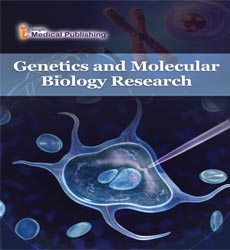Importance of Cancer Biology Research in Today's World and its Future Vision
Department of Pulmonary Critical Care and Sleep Medicine, AIIMS Delhi, India
- Corresponding Author:
- Ajay Kumar
Department of Pulmonary Critical Care and Sleep Medicine
AIIMS Delhi, India
E-mail: ajaykumar@gmail.com
Received Date: August 27, 2021; Accepted Date: September 13, 2021; Published Date: September 20, 2021
Citation: Kumar A (2021) Importance of Cancer Biology Research in Today's World and its Future Vision. Genet Mol Biol Res Vol No: 5 Iss No:5:56
Copyright: © 2021 Kumar A. This is an open-access article distributed under the terms of the Creative Commons Attribution License, which permits unrestricted use, distribution, and reproduction in any medium, provided the original author and source are credited.
Keywords
Cancer; Immunology
Introduction
Over 40 years prior, researchers concentrating on how retroviruses cause malignancy found the main human oncogene (a quality that can change a typical cell into a diseased cell). This novel and surprising understanding of disease advancement, and different experiences that followed, opened already neglected spaces of malignant growth science—at last prompting the time of exactness oncology and new ways to deal with malignant growth anticipation, identification, and treatment. The Cancer Genome Atlas recorded the genomic changes related to 33 unique kinds of malignant growth. These endeavors have uncovered various experiences in the hereditary bases of malignancy. For instance, the recognizable proof of hereditary likenesses across various sorts of tumors has prompted helpful methodologies that depend on sub-atomic qualities of tumors and not wherein the body's malignant growth begins [1]. Expanding on this present, NCI's Clinical Proteomic Tumor Analysis Consortium is spearheading the coordinated proteogenomic examination of a developing number of malignancy types.
The future aspects
The imagination of NCI-supported analysts and creative advancements will drive novel bits of knowledge never thought conceivable. These disclosures may incorporate new experiences into the reasons for malignancy and major exploration prompting treatment to leap forwards. New innovation may be fostered that alters disease research. The information acquired from our interests in essential exploration today will drive the upcoming advances to assist patients with malignancy and people in danger of the sickness. Researchers will have an extensive comprehension of malignancy science that catalyzes the advancement of fresher and more secure approaches to forestall, recognize, analyze, and treat disease. Disease immunotherapy has arisen as an amazing asset in malignant growth treatment. The key knowledge was that a patient's own resistant framework could be bridled to perceive and obliterate disease cells. On account of many years of NCI-and NIH-subsidized essential examination, this knowledge has prompted new medicines that have saved or broadened the existences of numerous patients. Researchers are working perseveringly to further develop flow immunotherapy draws near, and promising new spaces of chance are being distinguished. For instance, scientists are investigating the utilization of extra kinds of invulnerable cells as malignant growth intercessions and exploring how microbiomes, the networks of organisms that occupy the gut and different tissues, shape the insusceptible framework and reactions to disease treatment. Researchers imagine this exploration prompting a future when a patient's disease cells, the cell piece of their tumor, and the situation with their insusceptible framework and gut microbiome will be atomically portrayed. This data will advise treatment choices and checking of treatment reactions. A particularly of complete examination a patient and their malignancy might highlight mixes of medicines that focus on numerous components and offer a superior opportunity for a fix [2].
Cancer immunotherapies
Most accessible immunotherapies, like safe designated spot inhibitors and illusory antigen receptor (CAR) T-cell treatments, center around resistant cells called cytotoxic T cells, which are essential for the versatile, or explicit, invulnerable framework. Cytotoxic T cells perceive and kill malignant growth cells that show explicit atoms (antigens) on their surfaces. Malignant growth analysts have gone to the inborn, or vague, resistant framework, also, trying to tap its potential for disease immunotherapy. The natural insusceptible framework gives the main line of guard against contaminations and strange cells. This safeguard doesn't need the acknowledgment of antigens. Nonetheless, when a natural invulnerable reaction has been started, a versatile safe reaction is animated, and both work together to kill diseases or different dangers to the body. NCI-subsidized examiners have as of late discovered better approaches to use the intrinsic insusceptible situation against malignancy and control it to further develop disease immunotherapy [3].
Aiding Macrophages to engulf Cancer cells
Macrophages are natural insusceptible cells that immerse and condensation malignant growth cells, cell garbage, microscopic organisms, and other unfamiliar substances. Ordinary cells are shielded from being eaten by macrophages since they show a protein called CD47 on their surface. Essentially, CD47 is a "don't eat me" sign to macrophages. Numerous malignancy cells, in any case, likewise show CD47 on their surface, shielding them from macrophages. NCI-supported analysts at Stanford University and their teammates have fostered a counteracting agent, presently being tried in clinical preliminaries, that blocks CD47, making disease cells helpless to assault and engulfment by macrophages. Peruse how Allen from Maryland profited from this test drug.
Likewise, another gathering of University of Pennsylvania analysts as of late exhibited that the digestion of macrophages can be "revamped," empowering them to eat disease cells regardless of whether they express CD47.
References
- Zitvogel L (2021) The microbiome and human cancer. Science 371: 6536
- Sharma KA (2021) Microbiome dysbiosis in cancer: Exploring therapeutic strategies to counter the disease. Semin Cancer Biol 70: 61-70
- Sharma KA (2021) Probiotics in microbiome ecological balance providing a therapeutic window against cancer. Semin Cancer Bio70: 24-36.
Open Access Journals
- Aquaculture & Veterinary Science
- Chemistry & Chemical Sciences
- Clinical Sciences
- Engineering
- General Science
- Genetics & Molecular Biology
- Health Care & Nursing
- Immunology & Microbiology
- Materials Science
- Mathematics & Physics
- Medical Sciences
- Neurology & Psychiatry
- Oncology & Cancer Science
- Pharmaceutical Sciences
